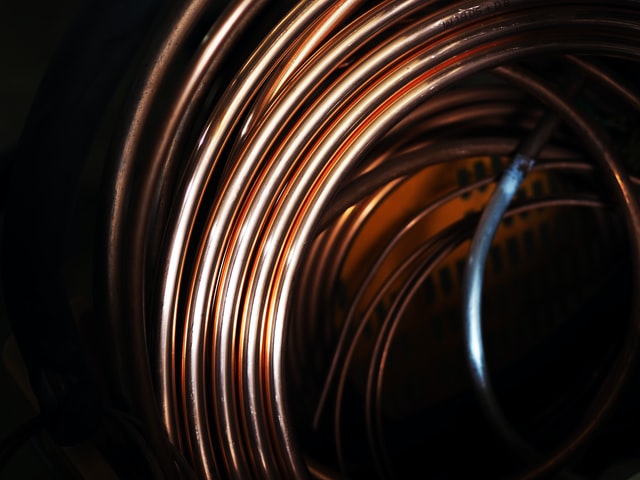The Evolution of Copper
 A few weeks ago, Dr. Copper, (aka Dr. John Gross), shared a retrospective history of the copper industry in his Copper Journal
A few weeks ago, Dr. Copper, (aka Dr. John Gross), shared a retrospective history of the copper industry in his Copper Journal
In the report he had a chart showing the red metal’s consumption by end-user market based upon information from the Copper Development Association. There were also two charts showing wire mill product market share by market … in 1970 and then in 2023.
Personally, I don’t know if this is based upon dollars or units (as I know someone will ask) but, even taking into account price changes, the share change is significant.
I shared the report with Chris Sokoll, President of DISC Corp, which provides many distributors, reps, and manufacturers with electrical market size and segment information (and with planning season coming, your company should be using his information as a common industry benchmark and should be subscribing to his Flash reports).
For those who don’t know Chris, he acquired DISC after a distinguished career in the wire / cable market and still retains many relationships there.
He shared thoughts on the good doctor’s information on the changes in the copper market.
The Evolution of Copper
Copper, a reddish-orange metal known for its excellent conductivity, malleability, and corrosion resistance, has played a pivotal role in human civilization for thousands of years. Its utilization has evolved significantly from the 1940s to the present day, driven by technological advances, industrial demands, and sustainable practices. Today copper represents as much as 20% or more of the electrical distributors’ gross sales. This metal is a key to our continued need for electrification. It’s time to take a good look at where we have been to help us make better predictions of the future. I spent the bulk of my career in the wire and cable industry and have seen first had the up and downs of the global copper market.
Looking back, the 1940s marked a period of intense industrial activity, largely driven by World War II. Copper was a critical material in military applications, including wiring for communication systems, electrical machinery, and weaponry. Its excellent electrical conductivity made it indispensable in the manufacturing of radio and radar equipment, as well as in aircraft and ships. During this period, the demand for copper soared, prompting increased mining and refining efforts.
Post-war, the copper industry experienced rapid growth, fueled by reconstruction and economic expansion across North America and Europe. Copper’s role expanded into civilian infrastructure—wiring in homes, electrical grids, and transportation systems—laying the groundwork for our modern electrical infrastructure. However, the era was also characterized by resource limitations, leading to increased recycling of scrap copper to meet growing demand.
In the following decades, the advent of new technology further elevated copper’s significance. The expansion of electrical grids to accommodate rising power consumption amplified demand for copper wiring and conductors. While aluminum was, and continues, to be used for long distance transmission and distribution, copper became the backbone for homes, business and industry. The development of television, computers, and other electronic devices also contributed to increased consumption.
New innovations over the last decades in mining and refining technology improved copper production efficiency. The introduction of open-pit mining and solvent extraction-electrowinning (SX-EW) processes enhanced extraction from low-grade ore deposits, making copper more accessible. Copper projects like the massive Bingham Canyon Mine in Utah became symbols of large-scale industrial resource extraction.
Environmental awareness began to emerge as a concern, prompting industry efforts to improve recycling processes. The concept of sustainable resource management gained traction, leading to increased recovery of copper from scrap materials. The 1960s also saw the rise of the electronics industry, whose insatiable demand for high-purity copper components drove the development of specialized refining techniques.
The 1970s experienced economic upheaval, with oil crises and inflation impacting global markets. Copper prices fluctuated significantly due to geopolitical instability, economic recessions, and changing supply-demand dynamics. Despite these challenges, technological progress continued, especially in the fields of telecommunications and aerospace.
During this period, concerns about resource depletion led to greater emphasis on recycling. The development of advanced smelting and refining technologies allowed for the efficient reuse of copper, reducing reliance on primary ore extraction. Additionally, new alloys and materials began to emerge, though copper remained dominant in electrical applications. The rise of the computer age in the 1980s further increased demand for high-quality copper in electronics and data communications.
With globalization, copper mining and production became more geographically dispersed, especially with the emergence of new markets in Asia. Countries like Chile, Peru, and China became dominant players, significantly impacting global supply chains.
Sustainable practices have gained further prominence, with initiatives promoting recycling and environmental management. The concept of the “copper cycle”—from mining to manufacturing and recycling—became central to strategic planning. The development of underground and open-pit mining methods became more environmentally conscious, with a focus on reducing ecological footprints.
Technological innovations in electronics, such as the proliferation of personal computers and mobile phones, led to sustained demand for high-purity copper used in wiring, connectors, and circuit boards. Additionally, the rise of renewable energy sources, like wind and solar power, created new markets for copper in wiring and power electronics.
Today, copper is recognized as a critical material in the transition to a sustainable, low-carbon future. Its unparalleled conductivity makes it essential in electrical infrastructure, electric vehicles (EVs), and renewable energy systems. The rapid expansion of EVs has driven a surge in copper demand, with manufacturers seeking larger amounts of copper wiring and components.
Furthermore, innovations in mining, such as biomining and drone-assisted exploration, aim to reduce environmental impacts and improve efficiency. Recyclability remains a core principle, with nearly 50% of copper supplied from recycled sources globally.
Copper’s role in emerging technologies is expanding, including electric grid modernization, energy storage, and smart city infrastructure. Its antimicrobial properties are also being exploited in health-related applications, especially pertinent in the wake of global health challenges.
Copper continues to be the metal of modernization, and its use and re-use is unlikely to change anytime soon.
Take Aways
- If you’d like a copy of the May 16th issue of The Copper Journal, contact John Gross, or email me.
- As everyone involved in the industry knows, copper pricing has continued to go up, touching and exceeding $5.00 recently. It “bounces” but has stayed above $4.00. With concerns about a possible tariff or other trade / industrial policy dynamics, very doubtful you will see if go down and stay at a lower basis for a sustained period of time.
When you look at Chris’ historical timeline, and the “why”, and couple it with the “stated / understood” reasoning for tariffs … to stimulate the industrial market (making more in the US) and national security, we seem to be revisiting history, starting in the 1940’s. This can only further buoy the need, and hence the market, for copper.
As a distribution industry, we currently have two major players … Southwire and Prysmian. There are some strong “next tier” and then regional / niche players. Expect to see some consolidation. There are some PE firms that own some wire / cable companies and there are some family-owned companies. With the market looking up (demand and price) and probably some investment needed, it seems like opportunities for some.
And then there are other products that are primarily / all copper-based as well as those with copper as a component. Expect some price increases over time for the “copper as a component” companies. For those like copper pipe / conduit or fittings, expect, eventually, price increases and maybe some consolidation depending upon the company / product category.
As Chris says, “the evolution of copper.”






















